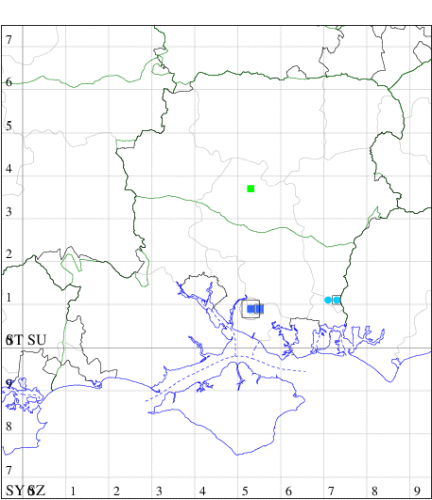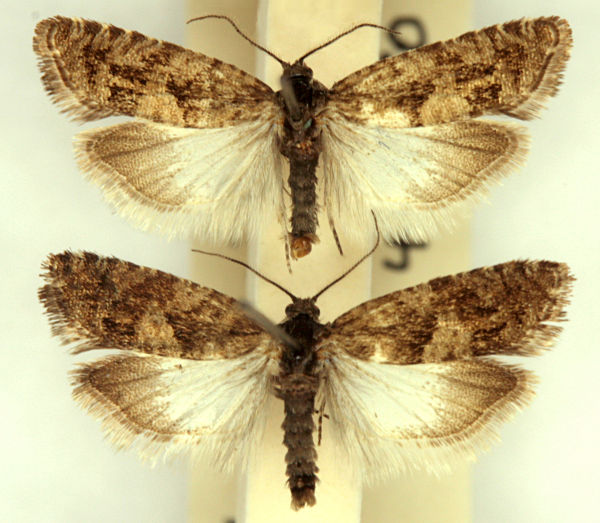Epinotia pygmaeana
Checklist Number49.246 [B&F: 1130]
Verification
Record will normally be accepted but photo evidence may be required - check with CMR if not sure of identity
Classification
| Family: | Tortricidae |
| Subfamily: | Olethreutinae |
| Genus: | Epinotia |
| Species: | pygmaeana |
| Authority: | (Hübner, [1799]) |
Nationally scarce (Nb) in coniferous woodland, plantations and gardens in parts of Britain. In Hampshire formerly locally common amongst spruce, especially in young plantations, but recorded recently only from Botley Wood, Havant Thicket and Micheldever Wood. Not recorded from the Isle of Wight to date. Wingspan 12-14 mm. The strongly biciliate-fasciculate antenna of the male and in both sexes the pure white area of the hindwing, together with the lack of a developed ocellus in the forewing, distinguish E. pygmaeana from E. subsequana [Bradley]. Larva feeds on Norway Spruce, living between needles spun together with silk, over-wintering as a pupa.


The abundance in each month is indicated as follows:
 No records
No records Very occasional
Very occasional Irregular
Irregular Uncommon
Uncommon Off-peak, but not unusual
Off-peak, but not unusual Off-peak, but not unusual
Off-peak, but not unusual Main flight time
Main flight time| J | F | M | A | M | J | J | A | S | O | N | D | |
|---|---|---|---|---|---|---|---|---|---|---|---|---|
| Adult |  |  |  |  |  |  |  |  |  |  |  |  |
| Larval |  |  |  |  |  |  |  |  |  |  |  |  |
Records by week (adult)
Records by week (larval)
VC11 South Hampshire
| Site | Date | Quantity | Recorder | Stage |
|---|---|---|---|---|
| Botley Wood (SU50) | 05/04/1980 | - | J R Langmaid, P H Sterling | Adult |
| Havant Thicket (SU71) | 05/04/1980 | one | J R Langmaid, P H Sterling | Adult |
| Havant Thicket (SU71) | 11/05/1980 | - | John R Langmaid | Adult |
| Botley Wood (SU50) | 17/05/1980 | - | John R Langmaid | Adult |
| Botley Wood (SU50) | 16/04/1981 | - | John R Langmaid | Adult |
| Botley Wood (SU50) | 28/03/1982 | one | J R Langmaid, D H Sterling | Adult |
| Botley Wood (SU50) | 18/04/1982 | - | J R Langmaid, E C Pelham-Clinton | Adult |
| Botley Wood (SU50) | 02/06/1985 | one | J R Langmaid, E C Pelham-Clinton, D H Sterling | Adult |
| Botley Wood (SU50) | 21/05/1990 | one | Richard J Dickson | Adult |
| Botley Wood (SU50) | 24/05/1991 | one | John R Langmaid | Adult |
VC12 North Hampshire
| Site | Date | Quantity | Recorder | Stage |
|---|---|---|---|---|
| Micheldever Wood (SU53) | 29/03/2002 | - | Brian Elliott | Adult |


.jpg)